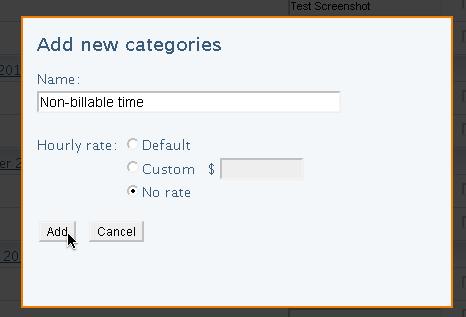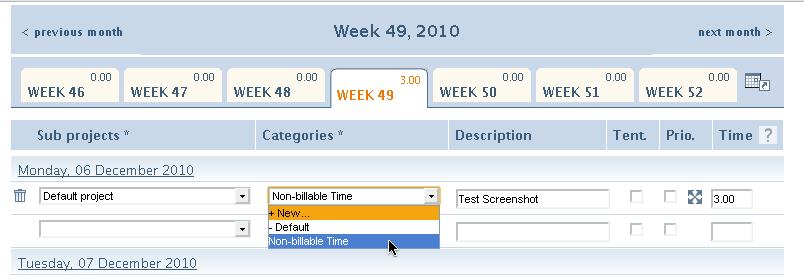Timesheet Feature Review #3: Billable vs Non-Billable Distinction
Many timesheet users are companies that perform contract or “outsourced” work, charging for their specialist services on an hourly, daily or retainer basis. This includes professional service firms such as accountants, lawyers, graphic designers, engineers, architects, web developers, PR firms and many more.
For these companies, using time tracking software isn’t just about internal auditing and accounts. For them, the timesheet system is arguably the single most important software that they deal with on a daily basis. Companies that bill their work to clients must be able to generate reports that accurately reflect their work done and the hours put in by their workers. However, as any working adult knows, not every minute spent on the job can reasonably be billed. This makes the billable vs non-billable distinction one of the top must-have features for timesheets.
Not All (Billable) Time Is Created Equal
In the highly competitive world of contract and professional services work, clients are demanding greater transparency and accountability. They are becoming less accepting of paying for “filler time” or time where they don’t see good progress being achieved. For companies that bill their time to clients, this means that every minute billed must be accounted for and justified by productivity and outputs achieved; most clients won’t settle for anything less.
When entering time into a timesheet, the problem with not being able to distinguish between billable and non-billable work becomes glaringly obvious; without this distinction, you won’t be able to log time at all without billing your clients for it. This would create a problematic scenario where you need to trade-off between accounting for the time spent on the project and billing your clients reasonably for the work done.
Take web development for example, coding isn’t always a straightforward and easy task. Sometimes, developers can take longer than expected to fix all the bugs in the website. Now when the developer gets around to entering time into the timesheet, he faces a dilemma: On one hand, he can’t always bill the extra time to his client because it may have been his fault for taking longer than expected to debug the code but on the other hand, leaving the timesheet blank would create a large, inaccurate, and potentially embarrassing void in the middle of his report. So, what can contractors do to side-step such tricky situations?
Enter one of the most useful timesheet features known to man: the ability to differentiate between billable and non-billable work.
What Exactly Does “Billable Work” Mean For Timesheets?
When performing contract work, you need to ensure that your final reports are clear and concise. These final reports are the “receipts” that you submit in order to get paid by your clients. When submitting your reports to external clients, it becomes even more important that you are able to account for every single minute spent on the job and can justify every minute billed to your clients. This will help minimize any disputes with your clients over your charges and final bills. Billable work is simply a term used to describe time that you are charging your clients for. In other words, it is the time logged into the timesheet for which you are actually getting paid.
The concept behind billable and non-billable work distinction is simple: Log all the time spent while on the job into the timesheet but only bill the client for time when work is actually progressing. This way, you are now able to accurately account for all the time that you’ve spent on the job while only charging your clients for “actual work” done.
The advantage of such a system is immediately obvious, your clients will be able to see exactly what your workers were doing on the job and at the same time, they will also not be able to reasonably dispute the time billed to them. This way, you present both accountability and professionalism in your final bills, two highly-prized characteristics for any contracting company or services firm.
When Will I Not Need to Distinguish Between Billable and Non-billable Work?
The whole “billable/non-billable work” concept is only relevant to contract work. When using timesheets for internal purposes, auditing or payroll, this feature is rarely used at all. If your company is only interested in using timesheets to track internal progress and time spent on corporate projects, then the billable/non-billable distinction will not be a “must have” feature for you. Other examples of organizations that do not need to distinguish between billable/non-billable time include government agencies and non-profit bodies. For these organizations, although it remains important to track time spent on projects, time is not billed to clients so distinguishing between billable/non-billable is less relevant.
Also, the billable/non-billable distinction can be foregone when working with an understanding client or a fixed price project. Not all clients operate the same way; some companies simply don’t care what you do with your time so long as you deliver a great end-product at a reasonable rate. Of course, when performing contract work, you are bound to run into all sorts of clients so getting a product with billable/non-billable distinction is still advisable for all companies that perform contract work.
In Conclusion
Like most other timesheet software features, being able to distinguish between billable and non-billable time is a feature that may be indispensible or completely irrelevant to your company. For almost all companies that bill time to clients, the ability to differentiate between billable and non-billable time will probably be the most important feature to look out for when shopping around for a timesheet product. On the other hand, for companies that deal solely with internal or corporate projects, this feature will rank pretty low in their books.
As it turns out, billable/non-billable time distinction is a fairly common feature. Of the 21 timesheet products reviewed by Software Shortlist’s panel, 17 products include this feature. I hope this article has helped you gain a better understanding of what billable/non-billable distinction actually does and why it is such a popular feature amongst timesheet software users.
Software Shortlist is currently counting down on a list of 13 “must have” timesheet features for prospective timesheet product buyers as suggested by our search data so stay tuned for our upcoming reviews!


